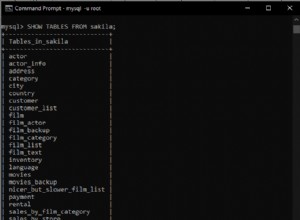poświęć trochę czasu na przeczytanie mojej odpowiedzi tutaj:(ma podobne tomy do Twojej)
500 milionów wierszy, skanowanie zakresu 15 milionów wierszy w 0,02 sekundy.
MySQL i NoSQL:pomóż mi wybrać właściwy
następnie zmień silnik tabel na innodb w następujący sposób:
create table tag_date_value
(
tag_id smallint unsigned not null, -- i prefer ints to chars
tag_date datetime not null, -- can we make this date vs datetime ?
value int unsigned not null default 0, -- or whatever datatype you require
primary key (tag_id, tag_date) -- clustered composite PK
)
engine=innodb;
zamiast tego możesz rozważyć następujące klucze:
primary key (tag_id, tag_date, value) -- added value save some I/O
ale tylko wtedy, gdy wartość nie jest jakimś DUŻYM typem varchar!
zapytanie jak poprzednio:
select
tag_date,
value
from
tag_date_value
where
tag_id = 1 and
tag_date between 'x' and 'y'
order by
tag_date;
mam nadzieję, że to pomoże :)
EDYTUJ
zapomniałem wspomnieć - nie używaj alter table do zmiany typu silnika z mysiam na innodb, ale raczej zrzuć dane do plików csv i zaimportuj je ponownie do nowo utworzonej i pustej tabeli innodb.
uwaga zamawiam dane podczas procesu eksportu - indeksy klastrowe to KLUCZ!
Eksportuj
select * into outfile 'tag_dat_value_001.dat'
fields terminated by '|' optionally enclosed by '"'
lines terminated by '\r\n'
from
tag_date_value
where
tag_id between 1 and 50
order by
tag_id, tag_date;
select * into outfile 'tag_dat_value_002.dat'
fields terminated by '|' optionally enclosed by '"'
lines terminated by '\r\n'
from
tag_date_value
where
tag_id between 51 and 100
order by
tag_id, tag_date;
-- etc...
Importuj
importuj z powrotem do tabeli we właściwej kolejności!
start transaction;
load data infile 'tag_dat_value_001.dat'
into table tag_date_value
fields terminated by '|' optionally enclosed by '"'
lines terminated by '\r\n'
(
tag_id,
tag_date,
value
);
commit;
-- etc...




